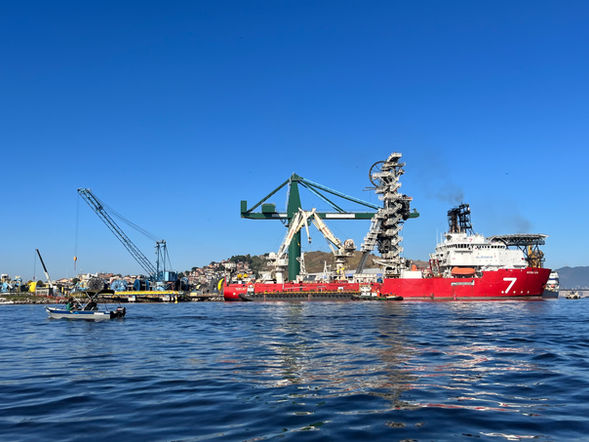Emergent Ecologies


Anchorage

Photo: Camila Pierobon. Date: 05/31/2023. Location: Rio-Niterói Bridge. The photograph offers a panoramic view of the fleet of tankers anchored in Guanabara Bay. They transport oil from the Santos and Campos basins to the refineries. These vessels remain at anchor, their engines roaring uninterruptedly, day and night. Completing this industrial scene, the outline of the Serra dos Órgãos appears in the background, outlining a landscape that contrasts with the human activity in the foreground.
Guardians of Guanabara Bay - Alexandre
Among the biggest problems faced by artisanal fishermen are conflicts with the oil industries and refineries, both national and international, which are present in the region. Among the companies involved are Petrobras, Shell, Total Energies, REDUC and others. These industries control an extensive area of the bay, which includes the use of underwater and land pipelines, as well as tankers that transport oil from the Santos and Campos Basins to the refineries, and areas where the ships anchor. The influence of these industries is clearly shown in the map below.

Source: PEA - Redes de Baía. Episode 1 - The Memory and History of Boat Traffic in Guanabara Bay, YouTube, minute: 8:11.
It is worth noting that this map does not depict the security areas designated by the Brazilian Navy, airport protection zones, fishing territories controlled by paramilitary groups, silted areas, or severely polluted regions where fishing is no longer viable. Taking all of these factors into account, artisanal fishermen are left with only 12% of the water available for fishing. In these areas, they still face competition from trawling and trapping, often conducted by armed actors, who remove tons of fish and crustaceans from Guanabara Bay.
Anchoring areas
Video about anchorage areas
Anchorage areas are spaces regulated by the state for vessels to anchor. Generally, the depth of these areas is artificially maintained through dredging processes. Consequently, the anchorage areas stand out as the deepest regions of Guanabara Bay, especially in the face of increased silting, as will be detailed below.
The depth of these areas produces cooler temperatures as compared to the waters in silted or shallow areas. As a result, artisanal fishermen say that fish and crustaceans of greater size and commercial value tend to remain in the anchorage areas. However, it is important to note that artisanal fishing is prohibited in these locations, and fishermen's risk their boats being seized by authorities if they fish there.
Despite this ban, some fishermen choose to risk it, a choice which they describe as a kind of last resort in the struggle to continue to make a living from fishing.
Noise and Light Pollution
Artisanal fishermen noted another challenge arising from the increase in tanker traffic– that of noise and light pollution.
With regard to noise, the fishermen argue that the large number of tankers anchored keep their engines running twenty-four hours a day. Due to the rapid propagation of sound underwater, the fishermen believe that this phenomenon results in a decrease in the number of migratory fish entering the bay. This problem is combined with the issue of light pollution since most small-scale artisanal fishing activities in Guanabara Bay take place at night. The lighting from the ships interferes with fishing in two ways: first, it makes it more difficult for migratory fish to enter the bay and, secondly, it makes fishing more challenging, as the fish tend to move to deeper, darker areas.
Siltation
Video: Camila Pierobon. Date: 15/06/2023. Location: Colônia Z10, Ilha do Governador. The video was taken at around 5am, during low tide. In it, the vast expanse of mud at the mouth of the Jequiá River is evident. Highlighted on the left is the Shellplant. In the background, Sugar Loaf Mountain and the center of Rio de Janeiro appear. On the caíco, we see an artisanal fishermen returning from a night's fishing, using his oar as he can't start his boat's engine because of the mud. Unfortunately, that night was not productive and he returned without fish.
Siltation represents one of the most critical challenges for artisanal fishermen. A significant portion of the areas where they can still fish are seriously affected by this phenomenon. Although the main motivation of this study was not to investigate the origins of siltation in the Guanabara Bay, it was possible to highlight some of its causes from the fishermen's accounts:
Uninterrupted Waste Disposal: There is a continuous flow of solid waste from the rivers that flow into the bay, intensifying the siltation process.
Mangrove deforestation: The rapid decline of mangroves, vital ecosystems for coastal health, has been identified as one of the causes of siltation.
Urban and Industrial Development: The establishment of industries, businesses, and housing in mangrove areas and around Guanabara Bay, often without legal authorization.
Dredging operations: Dredging operations carried out in anchorage areas release waste which, in turn, settles on the banks of the bay, aggravating the problem.
Siltation has profound and damaging implications for artisanal fishing. To begin with, artisanal fishermen plan their activities in harmony with the tides. Silting has an impact on this planning, as it is necessary to ensure that the fishermen return before the tide goes out completely. If they fail in their planning, they face the danger of seeing their boats stuck in thick mud, containing a high concentration of chemical waste. In situations where the fishermen are unable to return, the only option is to wait around six hours for the next high tide to allow them to pass. This scenario not only compromises the safety of the fishermen, but also has a direct impact on the efficiency and productivity of their work schedules.

Photo: Camila Pierobon. Date: 21/07/2023. Location: Colônia Z10, Ilha do Governador. The photograph shows young Kauê, the son of an artisanal fisherman, waiting for the tide to rise so he can return home. In the background, we see Shell's plant.
The warming of the waters in silted areas also presents a serious environmental and economic concern. In these places, the depth rarely exceeds one meter, even at high tide, leading to rapid warming of the water. In response to this thermal change, the fish, looking for more suitable conditions for their survival, migrate to areas with colder waters, such as boat anchorage areas, as we reported above. In more critical cases, warming can result in an increase in fish deaths, since the rise in water temperature can reduce the levels of oxygen available, making the environment inhospitable for aquatic life. This scenario not only affects biodiversity, but also has a negative impact on the local economy, especially for those who depend on artisanal fishing for their livelihoods.













